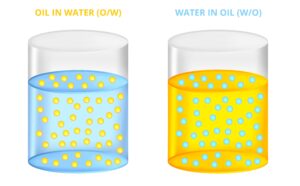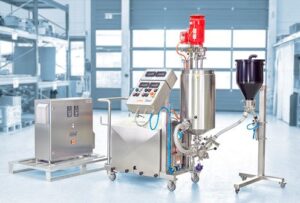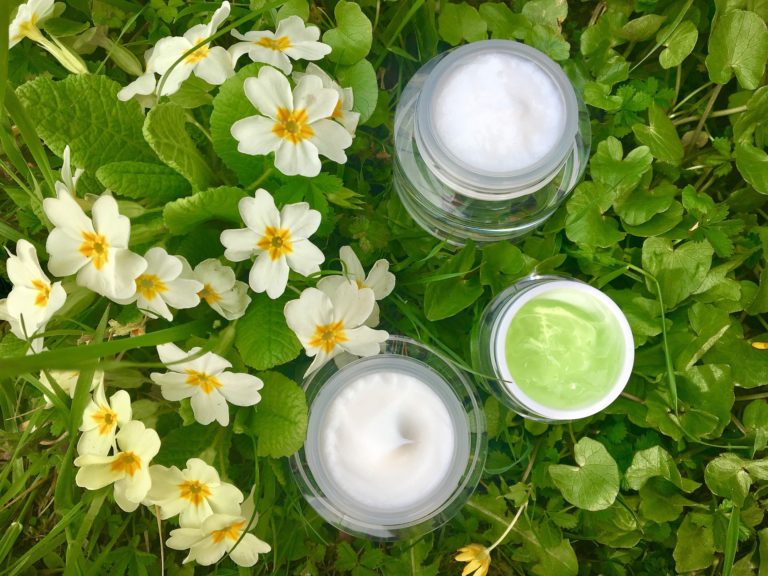2022.10.30
What is Emulsification in Cosmetics? Purpose, Types of Technology, and Benefits
Cosmetics we use are made with a technology called emulsification. Emulsification methods differ depending on the cosmetics simply produced and their functions. Emulsified particles made finer by the latest emulsification technology blend better with the skin than normal emulsification, and can contain more active ingredients.
In this column, we will briefly explain about emulsification and then describe the main emulsification technologies and their advantages.
Definition of Emulsification in Cosmetics
Emulsification in cosmetics such as creams, emulsions, and lotions refers to the state in which one of two liquids, which do not mix with each other, becomes a fine particle and is dispersed in the other, in order to combine water-soluble ingredients and oil at the same time. The two main types of emulsification are O/W emulsification, in which water surrounds oil, and W/O emulsification, in which oil surrounds water.

Purpose of Emulsification
Emulsification has the purpose of mixing water and oil ingredients to make them uniform and keep them that way. Without emulsification, cosmetic ingredients would be separated into water and oil, making them unusable as cosmetics. Emulsification technology can also make it easier for active ingredients to penetrate the skin by making the emulsion particles, which are a mixture of oil and water, finer and by increasing the amount of dispersed ingredients.
Emulsification Methods
The main method of emulsification is to add an emulsifier (surfactant) to the emulsion to reduce the interfacial tension, and to use physical energy to shear the emulsion to create an emulsion of oil and water. Recently, there is a demand for surfactant-free emulsification, and emulsification is sometimes performed without using chemical forces.
Mechanical Emulsification
Mechanical emulsification is a method of emulsifying by physical force. Generally, a homo-mixer or homogenizer attached to the manufacturing machine is rotated at high speed to apply force.
High-pressure emulsification to refine emulsified particles
High-pressure emulsification is used to make the emulsion particles finer. In normal emulsification, the particle diameter is about 10 μm, but with a high-pressure emulsifier, it can be as small as 200 to 300 nm. This makes it possible to produce moisturizing creams with a silky feel and to freely control the formulation.
Vacuum emulsification for stable quality
Vacuum emulsification is a process that prevents air bubbles from entering the cosmetics and ensures stable quality emulsions.

The tank is sealed to prevent evaporation of the water in the emulsion, thus allowing the production of cosmetics in the prescribed quantities. Since air is sucked out during mixing, there is no need to stop the machine for defoaming, which also has the advantage of eliminating the need for a process.
Chemical Emulsification
Chemical emulsification uses an emulsifier to chemically lower the interfacial tension and create emulsified particles. In addition to emulsification, maintaining stability to prevent separation after emulsification is also an important factor in chemical emulsification. There are many chemical emulsification methods, but this section describes emulsification techniques often used in the development of cosmetic formulations.
Trans-phase emulsification to produce uniform emulsion particles
The principle of phase-transfer emulsification is to add an aqueous phase to an oil phase in which a surfactant is dissolved or dispersed to generate a W/O emulsion in the initial stage, and then add another aqueous phase to invert the phase to generate an O/W emulsion. It is easy to obtain emulsions with relatively fine and uniform emulsified particles.
Amino acid gel emulsification method that produces a gel-like emulsion with stability.
In W/O emulsions that contain a lot of water, amino acids are used to make the oil phase gelatinous and provide high stability. By making the oil phase highly viscous, the water, which is the dispersed phase, is kept in place. The combination of water in which amino acids are dissolved and glycerol fatty acid esters, a naturally occurring surfactant, makes it possible to produce emulsified formulations that are not only stable but also pleasant to the touch and highly effective in retaining moisture.
Liquid crystal emulsification method that forms a lamellar structure
In O/W emulsification, the oil phase is dispersed in the liquid crystal formed by the surfactant to form a fine emulsion. In many cases, a double-chain surfactant is used as an emulsifier component, which makes the emulsion particles finer and facilitates the formation of a lamellar structure. The advantage of this technology is that the emulsion particles are less fragile than those of conventional emulsions, and the stickiness of the emulsion when applied to the skin can be reduced.

The emulsified particles combine to form a layer of oil and moisture, forming a lamellar structure similar to the skin structure, which allows the emulsion to penetrate deep into the stratum corneum while creating an oil film barrier on the skin surface.
(Reference) Emulsifier that forms lamellar structure>>JMIX OW-LC green
If you want to create highly functional cosmetics with emulsification technology, please contact us.
The acquisition of emulsification technology with such characteristics requires high-performance manufacturing facilities and formulation technology, and unless the company or individual possesses such facilities and formulation technology, it will take a great deal of time and cost to develop the technology. Even if a company has the formulation, it is often the case that it is not reproduced when the product is actually manufactured.

JC Dermatology Laboratory can provide samples of cosmetic ingredients, formulas, and benchmark cosmetics, as well as technical support. If you are interested in our services, please contact us even at the stage of consideration. Our expert researchers will be happy to propose the development of a formulation that suits your needs.

 contact
contact
